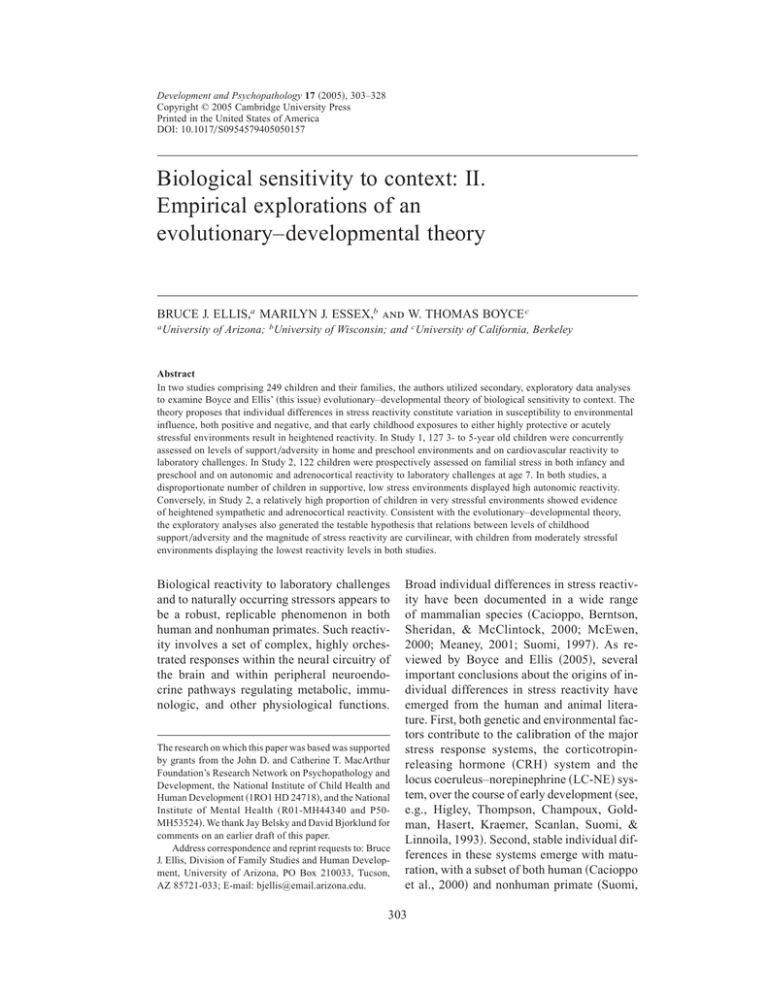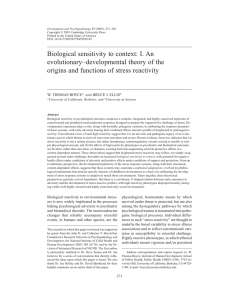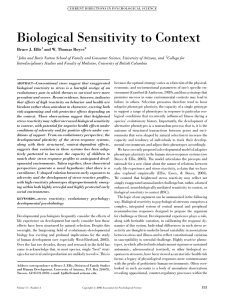Biological sensitivity to context: II. Empirical explorations of an evolutionary–developmental theory
advertisement

Development and Psychopathology 17 ~2005!, 303–328 Copyright © 2005 Cambridge University Press Printed in the United States of America DOI: 10.10170S0954579405050157 Biological sensitivity to context: II. Empirical explorations of an evolutionary–developmental theory BRUCE J. ELLIS,a MARILYN J. ESSEX,b and W. THOMAS BOYCE c a University of Arizona; b University of Wisconsin; and c University of California, Berkeley Abstract In two studies comprising 249 children and their families, the authors utilized secondary, exploratory data analyses to examine Boyce and Ellis’ ~this issue! evolutionary–developmental theory of biological sensitivity to context. The theory proposes that individual differences in stress reactivity constitute variation in susceptibility to environmental influence, both positive and negative, and that early childhood exposures to either highly protective or acutely stressful environments result in heightened reactivity. In Study 1, 127 3- to 5-year old children were concurrently assessed on levels of support0adversity in home and preschool environments and on cardiovascular reactivity to laboratory challenges. In Study 2, 122 children were prospectively assessed on familial stress in both infancy and preschool and on autonomic and adrenocortical reactivity to laboratory challenges at age 7. In both studies, a disproportionate number of children in supportive, low stress environments displayed high autonomic reactivity. Conversely, in Study 2, a relatively high proportion of children in very stressful environments showed evidence of heightened sympathetic and adrenocortical reactivity. Consistent with the evolutionary–developmental theory, the exploratory analyses also generated the testable hypothesis that relations between levels of childhood support0adversity and the magnitude of stress reactivity are curvilinear, with children from moderately stressful environments displaying the lowest reactivity levels in both studies. Biological reactivity to laboratory challenges and to naturally occurring stressors appears to be a robust, replicable phenomenon in both human and nonhuman primates. Such reactivity involves a set of complex, highly orchestrated responses within the neural circuitry of the brain and within peripheral neuroendocrine pathways regulating metabolic, immunologic, and other physiological functions. The research on which this paper was based was supported by grants from the John D. and Catherine T. MacArthur Foundation’s Research Network on Psychopathology and Development, the National Institute of Child Health and Human Development ~1RO1 HD 24718!, and the National Institute of Mental Health ~R01-MH44340 and P50MH53524!. We thank Jay Belsky and David Bjorklund for comments on an earlier draft of this paper. Address correspondence and reprint requests to: Bruce J. Ellis, Division of Family Studies and Human Development, University of Arizona, PO Box 210033, Tucson, AZ 85721-033; E-mail: bjellis@email.arizona.edu. Broad individual differences in stress reactivity have been documented in a wide range of mammalian species ~Cacioppo, Berntson, Sheridan, & McClintock, 2000; McEwen, 2000; Meaney, 2001; Suomi, 1997!. As reviewed by Boyce and Ellis ~2005!, several important conclusions about the origins of individual differences in stress reactivity have emerged from the human and animal literature. First, both genetic and environmental factors contribute to the calibration of the major stress response systems, the corticotropinreleasing hormone ~CRH! system and the locus coeruleus–norepinephrine ~LC-NE! system, over the course of early development ~see, e.g., Higley, Thompson, Champoux, Goldman, Hasert, Kraemer, Scanlan, Suomi, & Linnoila, 1993!. Second, stable individual differences in these systems emerge with maturation, with a subset of both human ~Cacioppo et al., 2000! and nonhuman primate ~Suomi, 303








